Application development has come a long way from the days of building apps locally and then pushing them onto a server sitting in a rack in a datacenter. Developers must now tackle modern tooling changes, new methodologies, more services, and many new concepts. For these reasons, the architecture needed to support large-scale deployments has become a focal point for most organizations.
Red Hat's Portfolio Architecture team has been developing reference architectures based on customers' real-world use cases in various industries for the past few years. We have multiple criteria for developing and vetting an architecture collection before publishing it, which you can read in my intro article about Portfolio Architectures.
We're publishing these architectures for anyone's use on our Red Hat Portfolio Architecture Center and community Portfolio Architecture Examples repository site.
This article focuses on architectures supporting application development across a diverse set of domains and cloud needs. There are currently 15 architectures in this collection. I'll provide a short overview of each and allow you to explore them in-depth on your own.
- Business optimization: Optimizing delivery routing, automating rostering of staff, and improving the efficiency of tasks across multiple stores.
- Cloud-native development: Building and running applications to fully exploit the advantages of the cloud computing model (responsive, elastic, and resilient applications).
- Omnichannel customer experience: Integrating and orchestrating channels such that there is a similar experience across all the channels someone chooses to use.
- Edge medical diagnosis: Accelerating medical diagnosis using condition detection in medical imagery with artificial intelligence (AI) and machine learning (ML) at medical facilities.
- Headless e-commerce: Deploying a container-based e-commerce website while moving away from tightly coupled existing e-commerce platforms.
- Integrating with SaaS applications: Integration with Software-as-a-Service (SaaS) applications, platforms, and services empowers organizations to build and run scalable applications in modern, dynamic environments such as public, private, and hybrid clouds.
- Intelligent Data-as-a-Service: Building and delivering systems and platforms in a secure and scalable manner while driving data needs for moving towards consumerization in healthcare.
- Modernizing testing with data synthesis: Modernizing testing with data synthesis is a testing innovation that focuses around enabling massive amounts of data to be available for business users and developers in a secure and scalable manner.
- Open banking: A cloud-ready, modular open source approach offering a wide range of technology options and allowing low-effort integration covering all aspects of an open banking implementation.
- Payments: Enabling financial institutions to offer customers fast, easy to use, and safe payment services available anytime, anywhere.
- Point of sale: Simplifying and modernizing central management of distributed point-of-sale devices with built-in support for container-based applications.
- Real-time stock control: Providing near-real-time stock positions and dynamic pricing promotions to retail omnichannels.
- Retail data framework: Creating a framework for access to retail data from customers, stock, and staff across multiple internal teams.
- Store health and safety: Managing effective in-store compliance, health and safety, and employee checks and procedures.
- Supply chain integration: Streamlining integration between different elements of a retail supply chain for on-premises, cloud, and other third-party interactions.
In the Red Hat Portfolio Architecture Center, you'll find a table of contents outlining the technologies used in each architecture, several example schematic diagrams with descriptions, and a link to open the diagrams directly into the online tooling in your browser.
Business optimization architecture
Retail is the process of selling consumer goods or services to customers through multiple distribution channels to earn a profit. Retailers satisfy customer demand identified through a supply chain.
The term retailer is typically applied when a service provider fills small orders from many individuals (end users) rather than large orders from a small number of wholesale, corporate, or government clients.
The business optimization architecture aids retailers by optimizing delivery routing, automating staff scheduling, and improving the efficiency of tasks across multiple stores.
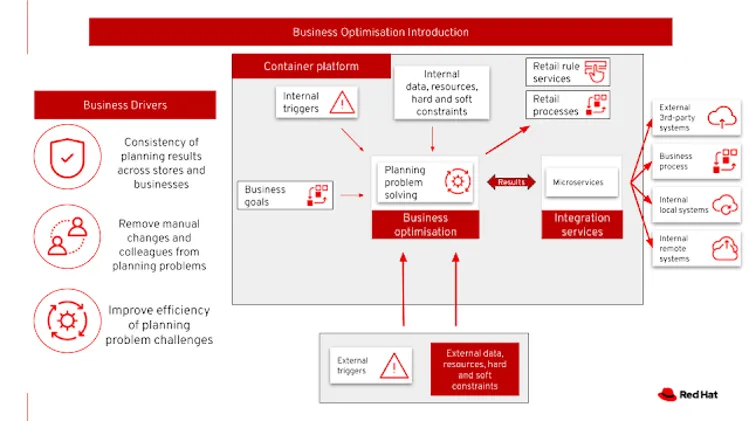
Cloud-native development architecture
Cloud-native development is an approach to building and running applications to fully use the advantages of the cloud computing model (responsive, elastic, and resilient applications). This approach empowers organizations to build and run scalable applications in modern, dynamic environments such as public, private, and hybrid clouds.
[ Learn how to Modernize your IT with managed cloud services. ]
Containers and orchestration, DevOps and continuous delivery, microservices and service meshes, and declarative application programming interfaces (APIs) are key building blocks of cloud-native application development. These technologies and techniques deliver loosely coupled systems that are resilient, manageable, and observable. Combined with robust automation, they allow businesses to make high-impact application improvements frequently and predictably with minimal effort and risk. Additionally, cloud-native architecture and technologies provide the foundation for newer development models such as serverless computing and Functions-as-a-Service.
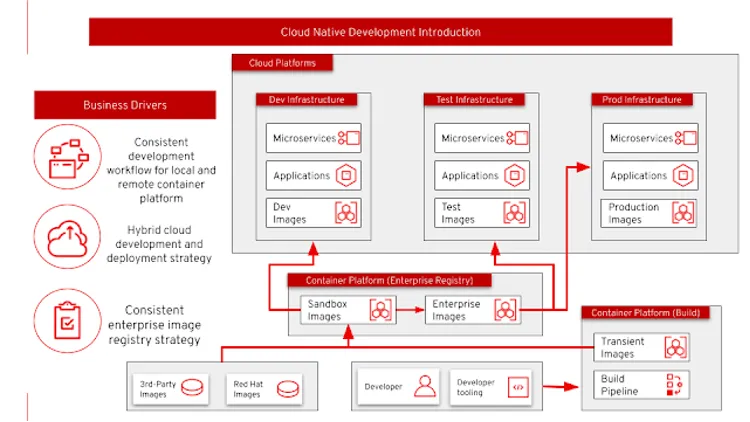
Omnichannel customer experience architecture
An omnichannel approach provides a unified customer experience across platforms, creating a single view for customers to interact with their own information.
This architecture provides a foundation for IT teams to develop and deliver omnichannel services through a combination of integration and process automation technologies. Agile integration defines how organizations transform and deliver on their digital promise to customers by integrating applications and services across on-premises infrastructure and cloud environments. Business automations, through process integrations, are captured to enable access to complex process services.
Omnichannel implies integration and orchestration of channels such that there is a similar experience across all the channels someone chooses to use.
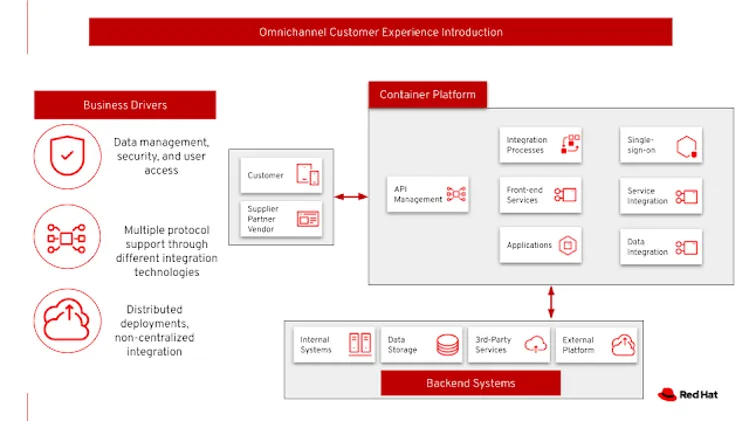
Edge medical diagnosis architecture
The edge medical diagnosis architecture services the healthcare industry. It accelerates medical diagnosis using condition detection in medical imagery with artificial intelligence (AI) and machine learning (ML) at medical facilities.
[ Download the Digital Transformation eBook for team tools to drive change. ]
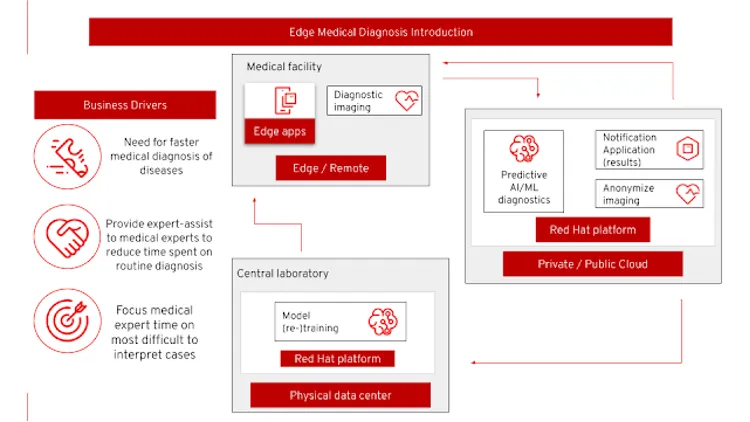
Headless e-commerce
E-commerce (electronic commerce) allows companies and individuals to buy and sell goods and services over the internet. The headless e-commerce architecture helps retailers deploy a container-based e-commerce website while moving away from tightly coupled existing e-commerce platforms.
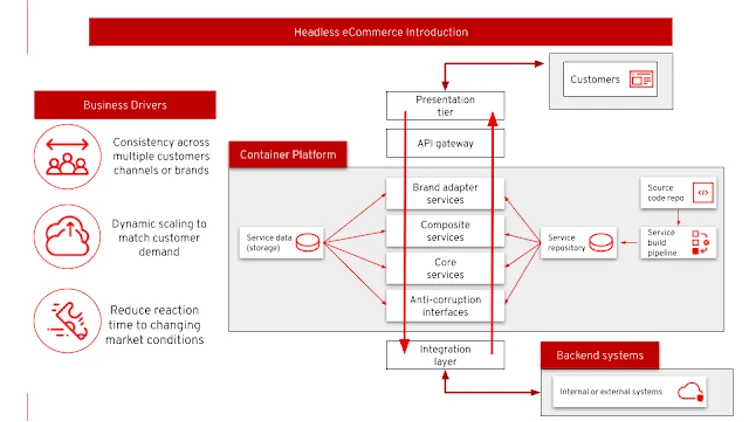
Integrating with SaaS applications
Integrating with Software-as-a-Service (SaaS) applications consists of operationally connecting SaaS solutions to separate computer systems or applications into a single larger system, allowing each solution to work together.
This architecture integrates SaaS applications, platforms, and services that empower organizations to build and run scalable applications in modern, dynamic environments such as public, private, and hybrid clouds.

Intelligent Data-as-a-Service (iDaaS) architecture
The intelligent Data-as-a-Service (iDaaS) architecture is about building and delivering systems and platforms in a secure and scalable manner while driving data needs for moving towards consumerization in healthcare.
[ Visit the Red Hat product trial center to gain hands-on experience, prepare for a certification, or assess if a product is right for your organization. ]
This architecture is about building and delivering systems and platforms in a secure and scalable manner while driving data needs for moving towards consumerization in healthcare.
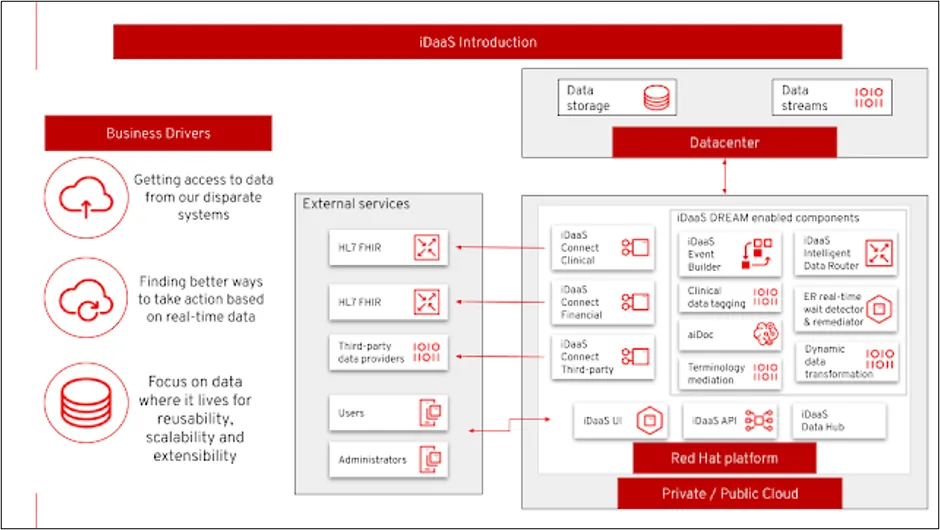
Modernizing testing with data synthesis
Data synthesis is about enabling innovation, focusing on allowing massive amounts of data to be available to business users and developers in a secure and scalable manner. This architecture's use case is for modernizing testing with data synthesis.
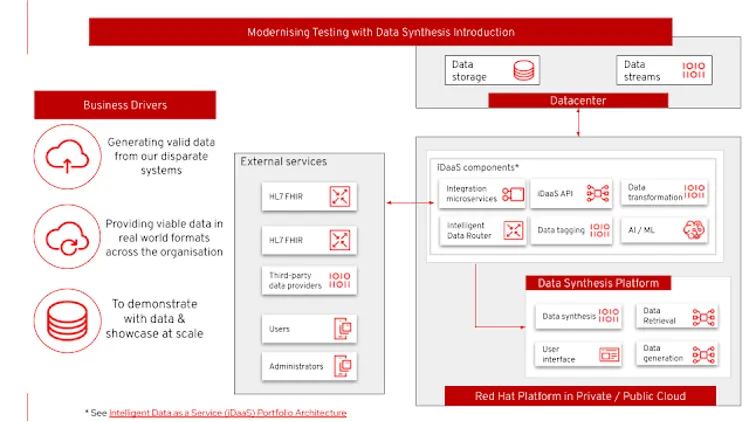
Open banking
Open banking provides technical and market advantages: Financial services institutions understand that today's banking customers expect fast, easy-to-use services they can tap into anytime, anywhere. Therefore, they are accelerating the adoption of digital technologies to enable a variety of new offerings.
The use case is a cloud-ready, modular open source approach offering a wide range of technology options. It allows low-effort integration covering all aspects of an open banking implementation. (Note: this project is a new architecture and is currently in progress, so I am sharing one of the schematic architecture diagrams. You can monitor this project for updates as it progresses.)
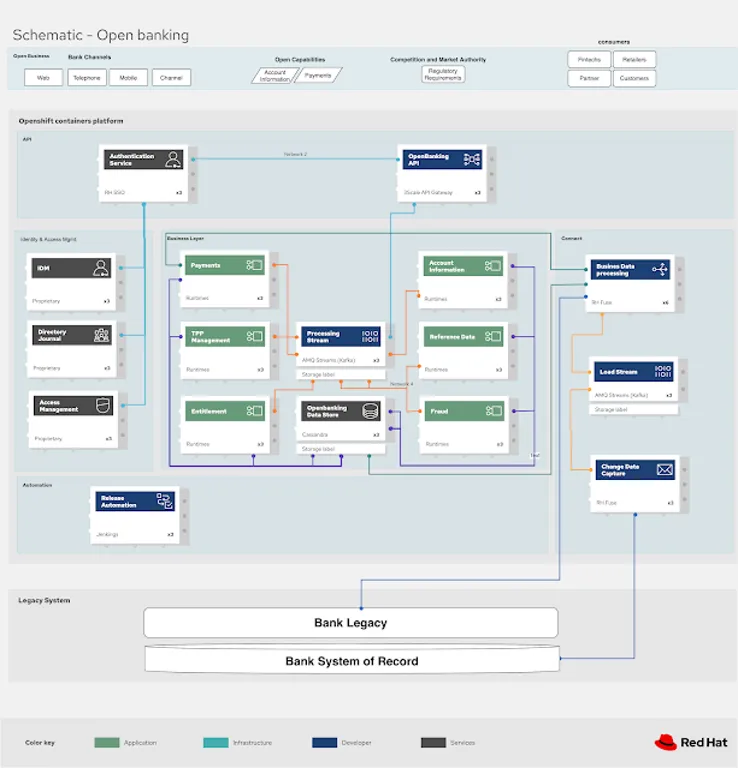
Payments
Enabling payments in (near) real-time lets businesses, consumers, governments, and others send and accept funds with fast availability to the recipient and instant confirmation to the sender. Enabling real-time (or at least fast) online payment experiences for customers gives banks a greater opportunity to win, serve, and retain customers. Banks can also drive higher payment volumes, ideally at lower costs, and engage new customer segments by building solutions that capture real-time payments.
This architecture helps financial institutions enable customers with fast, easy to use, and safe payment services available anytime, anywhere.
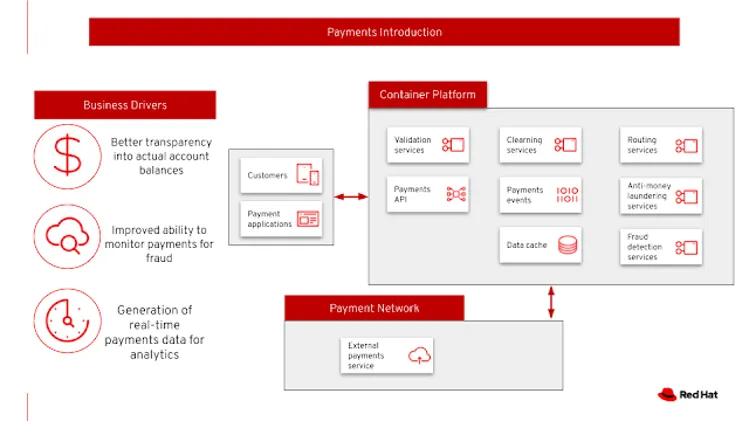
Point-of-sale architecture
A point of sale (or point of purchase) is the location where you charge customers. When customers check out online, walk up to your counter, or pick out an item from your stand or booth, they're at the point of sale. A point-of-sale system consists of the hardware and software that enables a business to make those sales.
The point-of-sale architecture simplifies and modernizes central management of distributed point-of-sale devices with built-in support for container-based applications.
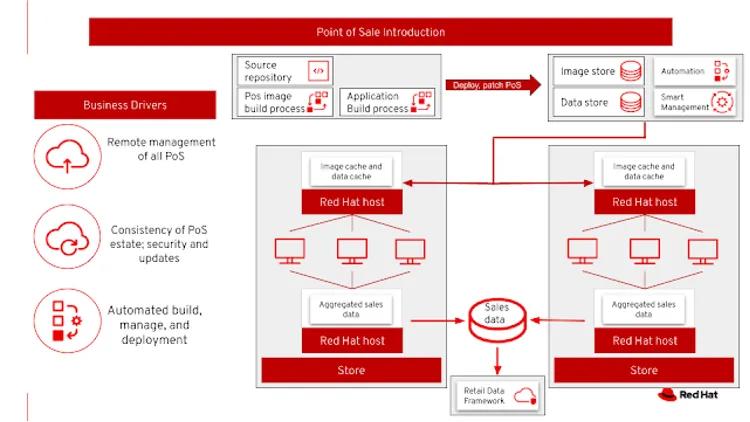
Real-time stock control
Real-time stock control (also known as inventory management) is an automated process that uses software to record sales and purchases. It gives a complete picture of what's happening with inventory, allowing businesses to react quickly to supply chain needs.
[ Learn how to explain orchestration in plain English by downloading this guide.]
The real-time stock control architecture provides near-real-time stock positions and dynamic pricing promotions information to omnichannel retailers.

Retail data framework architecture
A retail data framework handles managing enterprise retail data. The framework or system sets the guidelines and rules of engagement for business and management activities, especially those dealing with or resulting in data creation and manipulation.
The retail data framework architecture creates a framework for access to retail data about customers, stock, stores, and staff across multiple internal teams.
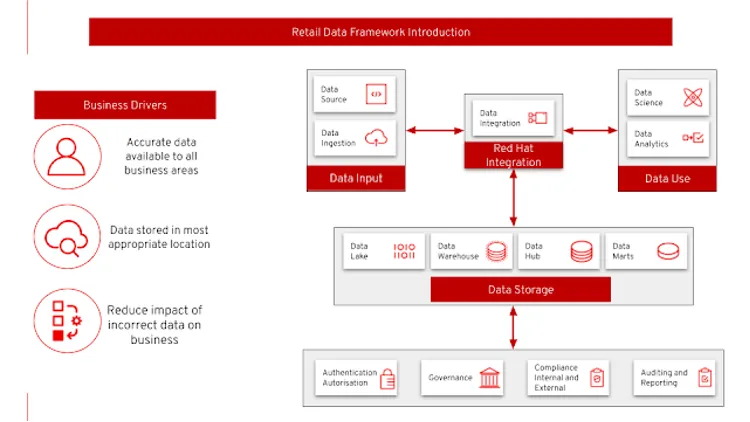
Store health and safety architecture
Store health and safety are all about managing risks to protect workers and stores. In a global context, health and safety are also an essential part of the movement toward sustainable operational growth.
The store health and safety architecture helps retailers manage in-store compliance, health, and safety. It also handles employee checks and procedures effectively.
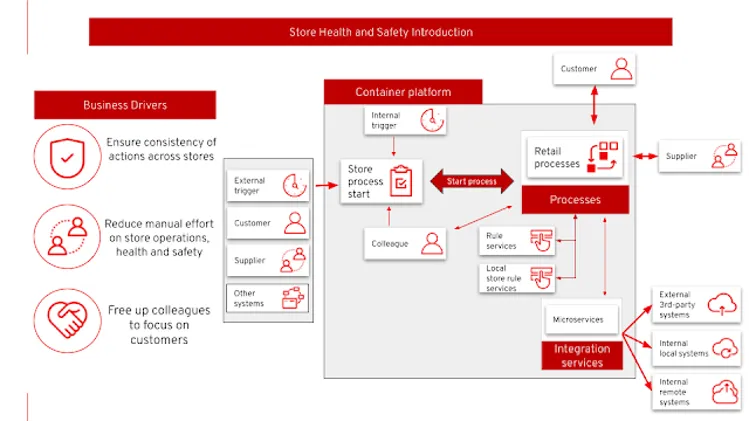
Supply chain integration architecture
Supply chain integration is a large-scale business strategy that aims to bring the chain's links into a closer working relationship with each other. The goal is to improve response and production time and reduce costs and waste.
The supply chain integration architecture's use case is to streamline integration between different retail supply chain elements for on-premises, cloud, and other third-party interactions.
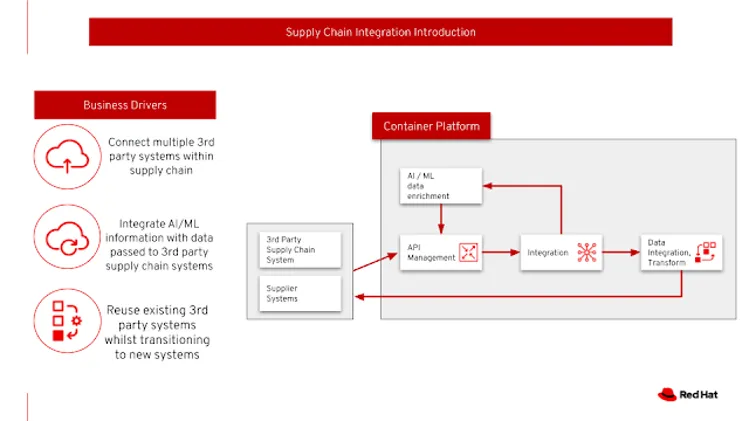
Learn more
These are 15 of the many reference architectures Red Hat's Portfolio Architects have published, and we'll continue to publish them as we complete them. If you are interested in more architecture solutions like these, feel free to export the Red Hat Portfolio Architecture Center.
This article originally appeared on Eric D. Schabell's blog and is republished with permission.
執筆者紹介
チャンネル別に見る
自動化
テクノロジー、チームおよび環境に関する IT 自動化の最新情報
AI (人工知能)
お客様が AI ワークロードをどこでも自由に実行することを可能にするプラットフォームについてのアップデート
オープン・ハイブリッドクラウド
ハイブリッドクラウドで柔軟に未来を築く方法をご確認ください。
セキュリティ
環境やテクノロジー全体に及ぶリスクを軽減する方法に関する最新情報
エッジコンピューティング
エッジでの運用を単純化するプラットフォームのアップデート
インフラストラクチャ
世界有数のエンタープライズ向け Linux プラットフォームの最新情報
アプリケーション
アプリケーションの最も困難な課題に対する Red Hat ソリューションの詳細
オリジナル番組
エンタープライズ向けテクノロジーのメーカーやリーダーによるストーリー
